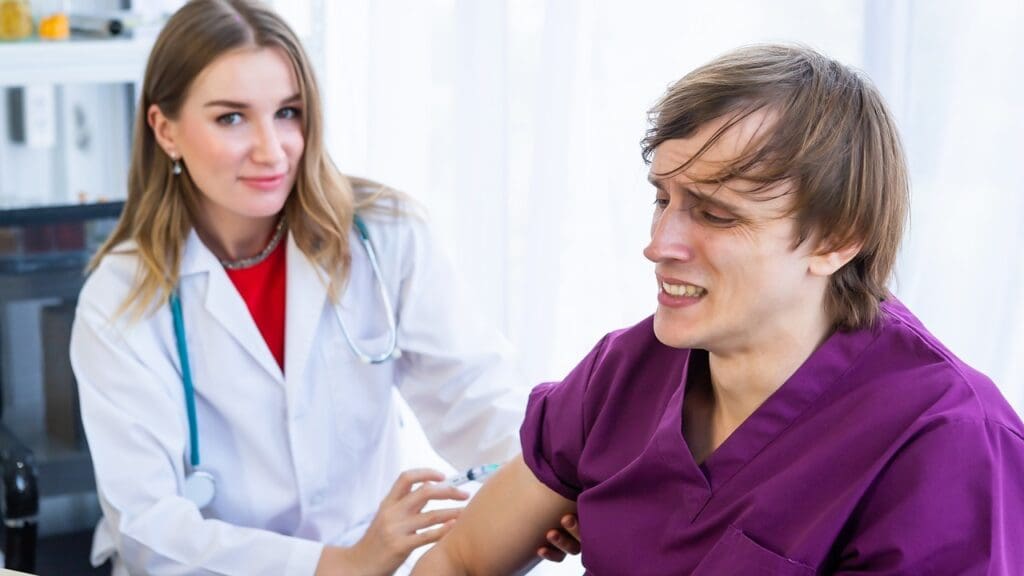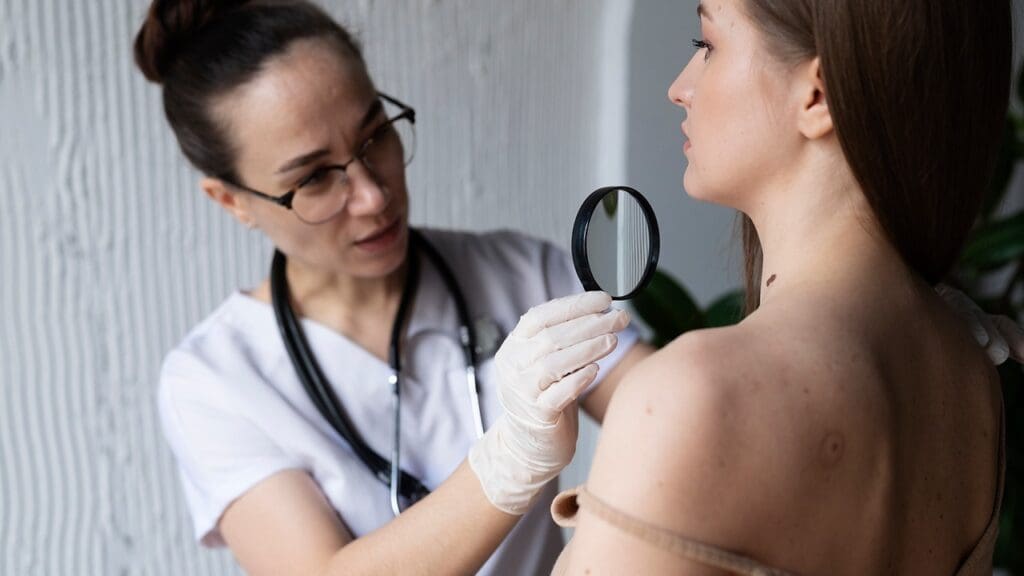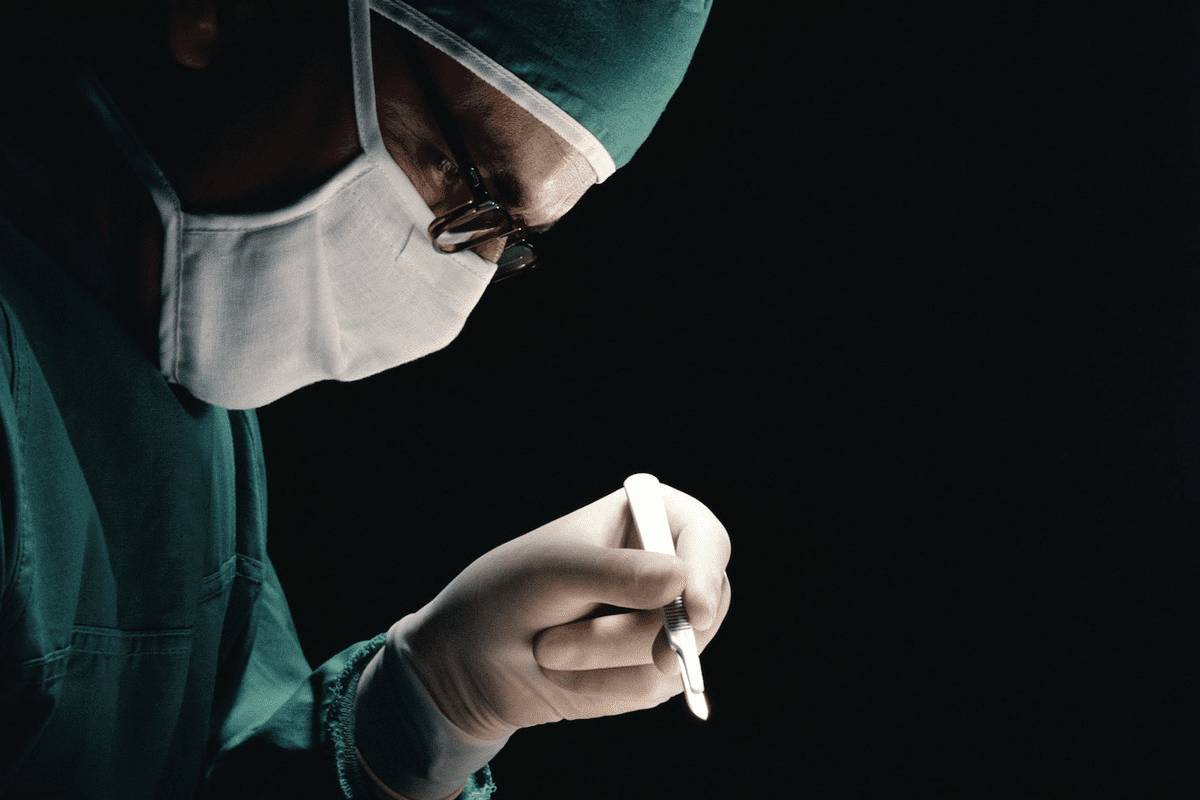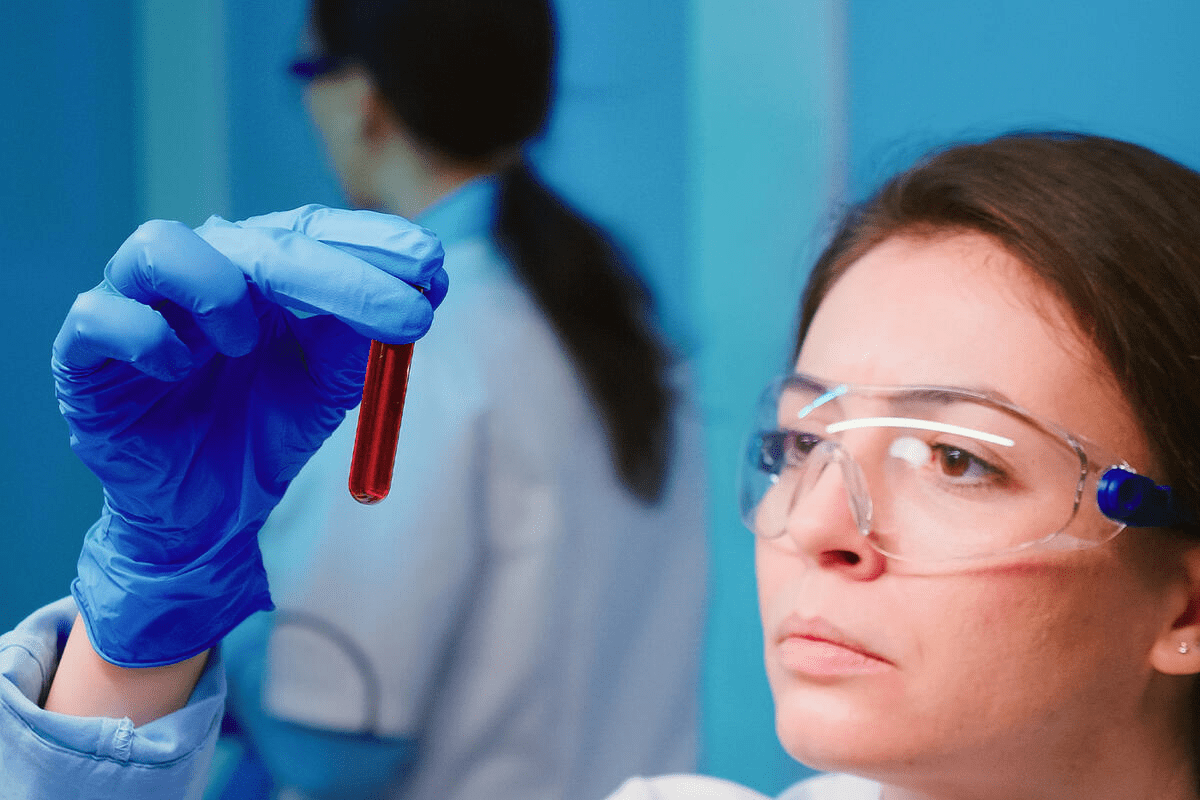Last Updated on November 27, 2025 by Bilal Hasdemir

Basal cell carcinoma (BCC) is the most common skin cancer worldwide. It’s important to catch it early and treat it well to avoid coming back.
At Liv Hospital, we stress the need for regular self-exams and doctor visits. Knowing how to diagnose and treat BCC is key. We guide you through all your options, from surgery to other treatments.
Key Takeaways
- Early detection is critical for successful basal cell carcinoma treatment.
- Regular self-checks and professional skin cancer screening are highly recommended.
- Liv Hospital offers a patient-centered approach to skin cancer treatment.
- Various treatment modalities are available, including surgical and non-surgical options.
- Post-treatment care is essential for minimizing the risk of recurrence.
Understanding Basal Cell Carcinoma
To understand basal cell carcinoma treatment, we must first know what BCC is and how it starts. Basal cell carcinoma is a common skin cancer that grows slowly. It usually doesn’t spread to other parts of the body.
What is Basal Cell Carcinoma?
Basal cell carcinoma is a tumor that comes from the basal cells in the skin’s outer layer. It often happens because of too much sun or tanning bed use. The most common places for BCC are sun-exposed areas like the face, ears, and hands.
Risk Factors and Causes
Many things can increase your chance of getting basal cell carcinoma. These include:
- Prolonged exposure to UV radiation
- Fair skin, light hair, and light eye color
- History of previous skin cancers
- Family history of skin cancer
- Exposure to certain chemicals like arsenic
- Weakened immune system
Knowing these risk factors helps in preventing and catching BCC early. Studies show people with skin cancer history are more at risk.
| Risk Factor | Description | Prevention Strategy |
|---|---|---|
| UV Exposure | Prolonged exposure to UV radiation from sun or tanning beds | Use sunscreen, wear protective clothing, avoid peak sun hours |
| Fair Skin | Individuals with fair skin, light hair, and light eyes | Regular skin checks, avoid excessive sun exposure |
| Family History | Family history of skin cancer | Regular screenings, genetic counseling if necessary |
Signs and Symptoms
Basal cell carcinoma can show up in different ways. It’s important to know its common signs and symptoms. These include:
- A shiny bump or nodule on the skin
- A pink or red patch on the skin
- An open sore that doesn’t heal
- A scar-like area that is white, yellow, or waxy
Spotting it early is key to treating it well. The ABCDE method helps identify BCC lesions: asymmetry, border irregularities, color variation, diameter, and evolving changes.
Diagnosis and Assessment
Diagnosing Basal Cell Carcinoma requires a visual check and advanced tests. It’s key to get a correct diagnosis to choose the right treatment for BCC.
Visual Examination
A dermatologist’s first step is a detailed look at the skin. A doctor says a dermatologist’s eye is essential for spotting moles. They look at the size, shape, color, and texture of the mole and check for more suspicious spots.
Skin Biopsy Procedures
A skin biopsy is often needed to confirm BCC. There are different biopsies, like shave, punch, and excisional biopsies. The choice depends on the mole’s size, location, and depth.
In a biopsy, a piece of tissue is taken and checked for cancer cells. This step is key to confirm BCC and decide on treatment.
Staging and Risk Assessment
After diagnosing BCC, the next step is staging and risk assessment. Staging finds out how big the cancer is and if it has spread. This helps plan the best treatment.
Risk assessment looks at how likely the cancer is to come back or spread. It considers the tumor’s size, location, and type, and the patient’s health.
Knowing about diagnosis and assessment helps patients prepare and make informed choices about their care.
Is Basal Cell Cancer Curable?
To understand if basal cell cancer is curable, we need to look at cure rates and how well treatments work. Basal cell carcinoma (BCC) is a common skin cancer. Knowing if it can be cured is important for patients.
Cure Rates and Prognosis
The cure rate for basal cell carcinoma is high, thanks to early detection and treatment. Studies show that over 90% of BCC cases are cured. Early detection is key to better treatment results.
When BCC is caught early, the outlook is good. Most patients fully recover from the disease. This shows that early diagnosis leads to excellent treatment outcomes.
| Treatment Stage | Cure Rate | Recurrence Rate |
|---|---|---|
| Early Stage | 95% | 5% |
| Advanced Stage | 80% | 20% |
Factors Affecting Curability
Several things can affect how curable basal cell carcinoma is. These include the cancer’s stage, the tumor’s size and location, and the patient’s health.
- Tumor Size and Location: Bigger tumors or those in sensitive spots (like around the eyes) can be harder to treat.
- Patient’s Health: People with weak immune systems might face a higher risk of the cancer coming back.
- Treatment Effectiveness: The type of treatment used and how well it works are also important for cure rates.
Recurrence Risks
Even though basal cell carcinoma is usually curable, there’s a chance it could come back. This can happen if the tumor wasn’t fully removed or if there are multiple BCC lesions.
Regular check-ups are vital to catch any signs of the cancer coming back early. It’s important for patients to stick to their follow-up plans. This helps catch any new problems quickly.
How to Treat Basal Cell: Surgical Options
Surgical treatments are a main way to fight BCC, with high success rates for small tumors. It’s key to know the different surgical methods and their benefits.
Mohs Micrographic Surgery
Mohs surgery is top for treating BCC, best for tricky or risky cases. It checks the tumor microscopically during surgery. This way, it removes the bad cells without harming the good ones nearby.
- High cure rates, often above 99% for primary BCC
- Tissue sparing, which is key for areas you want to look good
- Done in one go, with results right away
We suggest Mohs surgery for areas you really care about, like your face.
Standard Excisional Surgery
Standard excision removes the tumor and some healthy tissue around it. It works well for many BCC cases, chosen when the tumor is clear.
The good things about standard excision include:
- It gets rid of the tumor well
- It lets doctors check the removed tissue to make sure it’s all gone
- It’s good for many tumor sizes and places
We pick this method for tumors in less sensitive spots and for those who like a more classic surgery.
Curettage and Electrodesiccation
Curettage and electrodesiccation scrapes away the tumor with a curette. Then, it uses electric current to kill any cancer cells left.
This is good for:
- Superficial BCCs
- Tumors in low-risk spots
- People who can’t handle bigger surgeries
Each surgical option has its role in treating Basal Cell Carcinoma. Knowing the details of each helps us choose the best treatment for our patients. This way, we ensure the best results for everyone.
Treatment for BCC on Special Locations
Treating BCC in areas like the nose, face, ears, eyes, and scalp needs a careful approach. These spots are not just about looks but also have special challenges because of their anatomy and function.
BCC on Nose Treatment Approaches
Dealing with BCC on the nose is tough because of its key spot and the need to keep its shape and function. Mohs micrographic surgery is often the top choice for BCC on the nose. It lets doctors remove the tumor precisely while keeping healthy tissue.
“Mohs surgery has become the gold standard for treating skin cancers in cosmetically sensitive areas like the nose, it offers high cure rates and great cosmetic results.”
Mohs surgery on the nose is very effective. It helps in getting rid of BCC in this sensitive area.
BCC Removal on Face: Cosmetic Considerations
When taking out BCC from the face, looks matter a lot. The goal is to get rid of the cancer and keep the patient’s looks intact.
- Cosmetic Outcome: Mohs surgery is picked for its ability to save tissue and reduce scarring.
- Reconstruction: Sometimes, after removing the tumor, rebuilding might be needed. This could be with local flaps or skin grafts.
| Treatment Method | Cosmetic Outcome | Recurrence Rate |
|---|---|---|
| Mohs Surgery | Excellent | Low |
| Standard Excision | Good | Moderate |
Treatment for BCC on Ears, Eyes, and Scalp
BCC in the ears, eyes, and scalp needs special care because of their delicate nature. Around the eyes, careful surgical planning is key to avoid eye damage.
For the ears and scalp, treatment must focus on removing the tumor and looking good. Mohs surgery is again a great choice here because of its precision.
We know treating BCC in these areas is hard. Our experts are trained to give the best results, balancing treatment success with how it looks.
Non-Surgical Basal Cell Carcinoma Treatment
Non-surgical treatments for Basal Cell Carcinoma are becoming more popular. They offer alternatives to traditional surgery. Not every case of Basal Cell Carcinoma needs surgery. There are many non-surgical treatments that can help manage the condition.
Thinking about surgery can be scary for many. But, new medical technology and treatments have given us more options. These options are great for people with early-stage BCC, those with health issues, or those who don’t want surgery.
Cryosurgery (Freezing)
Cryosurgery uses liquid nitrogen to freeze cancer cells. It’s good for shallow Basal Cell Carcinomas and can be done in a clinic without hospital stay.
This method has little scarring and can reach areas surgery can’t. But, it’s not for all BCC types, like deeper or aggressive ones.
Radiation Therapy
Radiation therapy is another non-surgical option for Basal Cell Carcinoma. It kills cancer cells with high-energy rays. It’s great for the face or other areas where looks matter.
There are different types of radiation therapy. The choice depends on the tumor’s size, location, and the patient’s health.
“Radiation therapy offers a highly effective treatment for Basal Cell Carcinoma, even in areas where surgery might be disfiguring.” – Oncologist
Photodynamic Therapy
Photodynamic therapy (PDT) uses a light-sensitive drug and light to kill cancer cells. It’s good for shallow BCC and can treat big areas or many lesions.
PDT is usually safe with few side effects. But, it might need several sessions. Patients should avoid sunlight after treatment to prevent problems.
| Treatment | Indications | Benefits | Potential Drawbacks |
|---|---|---|---|
| Cryosurgery | Superficial BCC | Minimal scarring, quick procedure | May not be effective for deeper tumors |
| Radiation Therapy | BCC in cosmetically sensitive areas | High cure rates, preserves appearance | Potential for radiation-induced side effects |
| Photodynamic Therapy | Superficial BCC, larger areas or multiple lesions | Minimally invasive, effective for large areas | Requires multiple sessions, sunlight avoidance post-treatment |
New treatments, like VP-315, are being studied for BCC. These new options could lead to better treatments and more choices in the future.
Superficial Basal Cell Carcinoma Treatment Options
Treating superficial basal cell carcinoma often involves topical treatments. These are effective and gentle on the skin. They are a less invasive alternative to surgery, making them attractive to many patients.
Imiquimod Cream
Imiquimod cream is a topical treatment that boosts the body’s immune system to fight cancer cells. It is applied directly to the affected skin area, typically for several weeks. The effectiveness of imiquimod cream has been well-documented, with studies showing high clearance rates for superficial BCC.
Patients using imiquimod cream may experience some side effects. These include redness, itching, or swelling at the application site. These effects are generally manageable and may subside once treatment is completed.
5-Fluorouracil (5-FU) Cream
5-Fluorouracil cream is another topical treatment option for superficial basal cell carcinoma. It works by interfering with the growth of abnormal cells, causing them to die. The application of 5-FU cream is typically once or twice daily for several weeks.
Like imiquimod, 5-FU cream can cause local skin reactions. These include irritation, inflammation, and sometimes ulceration. But these side effects are usually temporary and resolve after treatment cessation.
Effectiveness and Application Guidelines
Both imiquimod and 5-FU creams have been shown to be effective in treating superficial BCC. Cure rates are comparable to more invasive treatments in some cases. The choice between these treatments depends on various factors, including the size and location of the tumor, as well as patient preference.
Application guidelines for these creams involve applying the treatment to the affected area once or twice daily for several weeks. It’s important to follow the specific instructions provided by a healthcare professional. This maximizes effectiveness and minimizes side effects.
Regular follow-up with a dermatologist is recommended. This is to monitor the response to treatment and address any concerns or side effects promptly.
Advanced and Recurrent Basal Cell Cancer Treatments
Treatment for advanced basal cell carcinoma has changed a lot with new targeted therapies. These new methods are helping manage the disease, even when old treatments don’t work.
Targeted Therapy with Hedgehog Pathway Inhibitors
Targeted therapy, like hedgehog pathway inhibitors, is key for advanced basal cell carcinoma. The hedgehog pathway is important in BCC growth. Drugs like vismodegib and sonidegib are approved, giving patients new hope.
These drugs block the hedgehog pathway, slowing tumor growth. Studies show they work well for advanced BCC, even with big tumors or spread.
Vismodegib and Sonidegib
Vismodegib and sonidegib are hedgehog pathway inhibitors for advanced basal cell carcinoma. Recent studies show they improve patient outcomes.
Both drugs block the hedgehog pathway but have different side effects and dosing. The choice depends on the patient and their disease.
Clinical Trials and Emerging Treatments
New clinical trials are looking at more treatments for advanced basal cell carcinoma. They include combination therapies and new targeted agents. These aim to better results, fewer side effects, and better patient care.
Treatment for Metastatic BCC
Metastatic basal cell carcinoma is rare but hard to treat. Targeted therapies and clinical trials are options. Hedgehog pathway inhibitors are showing promise, giving hope to those with few treatment choices.
We keep an eye on clinical trials and new treatments. We share updates on the best ways to manage advanced and recurrent basal cell carcinoma.
Recovery and Post-Treatment Care
After treating Basal Cell Carcinoma, the right care is key. It helps wounds heal well, avoids problems, and lowers the chance of cancer coming back.
Wound Care and Healing
Wound care is very important after BCC treatment, like surgery. Keep the wound clean and dry. Follow any dressing advice from your doctor and go to check-ups.
For small wounds, a simple dressing might do. But bigger surgeries need more care. We’ll help you take care of your wound right.
Managing Side Effects
Side effects can happen, depending on the treatment. Radiation might make the skin red and sore. Surgery can leave scars. We’ll talk about these and how to handle them.
Here are some common side effects and how to deal with them:
- Skin Irritation: Use gentle skin care products and avoid harsh soaps.
- Scarring: Follow scar care instructions, which may include silicone gel or sheeting.
- Pain: Manage pain with prescribed medications or over-the-counter pain relievers as directed.
Long-Term Monitoring and Follow-Up
Watching your skin closely is important after BCC treatment. This helps catch any new cancers early. We suggest regular check-ups, usually every 6 to 12 months, based on your risk and treatment.
| Follow-Up Interval | Actions |
|---|---|
| First Year | Follow-up every 3-6 months for clinical examination |
| After First Year | Annual follow-ups or as recommended based on risk assessment |
| Additional Care | Skin self-examinations monthly, sun protection measures |
Following the recommended care and check-ups can greatly improve your recovery. It also helps avoid complications and lowers the risk of cancer coming back.
Conclusion: Prevention and Future Outlook
As we wrap up our guide on treating basal cell carcinoma, it’s clear that prevention is key. Sun protection, regular self-checks, and professional screenings are vital. They help prevent and catch basal cell carcinoma early.
A doctor says these steps can greatly improve treatment results. Staying up-to-date with new BCC treatments helps patients make better choices. The future looks bright, with new research and therapies on the horizon.
We urge everyone to stay alert about their skin health. Talk to healthcare experts if you have any worries. Together, we can make a difference in preventing and treating basal cell carcinoma. This will lead to better outcomes and a better life for all.
FAQ
What is the treatment for basal cell carcinoma?
The treatment for basal cell carcinoma (BCC) varies. It depends on the tumor’s size, location, and depth. It also depends on the patient’s health. Options include surgery and non-surgical methods like Mohs micrographic surgery and radiation therapy.
Is basal cell cancer curable?
Yes, basal cell carcinoma is very curable, mainly when caught early. Most patients are cured with the right treatment. But, it’s important to watch for any signs of it coming back.
What are the treatment options for BCC on the nose?
For BCC on the nose, Mohs micrographic surgery is often used. It’s great for areas you want to keep looking good. Other treatments are also available, depending on the tumor and your health.
How is superficial basal cell carcinoma treated?
Superficial BCC can be treated with creams like imiquimod and 5-fluorouracil (5-FU). These creams are applied to the skin. Cryosurgery and photodynamic therapy are also options.
What is Mohs micrographic surgery?
Mohs micrographic surgery is a precise way to remove BCC. It’s good for sensitive areas or big tumors. It checks the tumor tissue during surgery to make sure it’s all gone.
Are there non-surgical treatments for basal cell carcinoma?
Yes, there are non-surgical treatments like cryosurgery and radiation therapy. These are for people who don’t want surgery or can’t have it.
How can I manage side effects after BCC treatment?
After BCC treatment, follow your doctor’s care instructions. This includes wound care and watching for complications. Always tell your doctor about any side effects.
What is the importance of long-term monitoring after BCC treatment?
Watching for signs of BCC coming back is key. Regular check-ups with your doctor are important. They help catch any problems early.
Can advanced basal cell carcinoma be treated?
Yes, advanced BCC can be treated. Options include new medicines like hedgehog pathway inhibitors. Clinical trials also offer new ways to treat it.
How can I prevent basal cell carcinoma?
To prevent BCC, protect your skin from the sun and avoid tanning beds. Know the risk factors. Regular skin checks and early detection are also important.
Reference
https://www.aad.org/dermatology-a-to-z/diseases-and-treatments/a—d/basal-cell-carcinoma








